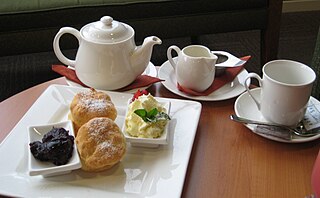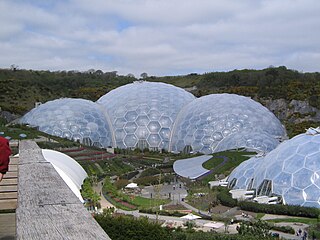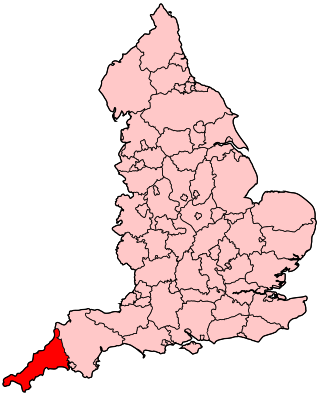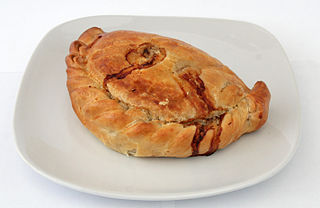
Cornwall is a ceremonial county in South West England. It is recognised as one of the Celtic nations and is the homeland of the Cornish people. The county is bordered by the Atlantic Ocean to the north and west, Devon to the east, and the English Channel to the south. The largest settlement is Falmouth, and the county town is the city of Truro.

Devon is a ceremonial county in South West England. It is bordered by the Bristol Channel to the north, Somerset and Dorset to the east, the English Channel to the south, and Cornwall to the west. The city of Plymouth is the largest settlement, and the city of Exeter is the county town.

A pasty is a British baked pastry, a traditional variety of which is particularly associated with Cornwall, South West England, but has spread all over the British Isles. It is made by placing an uncooked filling, typically meat and vegetables, in the middle of a flat shortcrust pastry circle, bringing the edges together in the middle, and crimping over the top to form a seal before baking.

A cream tea is an afternoon tea consisting of tea, scones, clotted cream, jam, and sometimes butter. Cream teas are sold in tea rooms throughout England, especially Devon and Cornwall, and in some other parts of the Commonwealth.

Clotted cream is a thick cream made by heating full-cream cow's milk using steam or a water bath and then leaving it in shallow pans to cool slowly. During this time, the cream content rises to the surface and forms "clots" or "clouts", hence the name. It forms an essential part of a cream tea.
Jamaican cuisine includes a mixture of cooking techniques, flavours and spices influenced by Amerindian, African, Irish, English, French, Portuguese, Spanish, Indian, Chinese and Middle Eastern people who have inhabited the island. It is also influenced by the crops introduced into the island from tropical Southeast Asia, many of which are now grown locally. A wide variety of seafood, tropical fruits and meats are available.

Devon is a county in south west England, bordering Cornwall to the west with Dorset and Somerset to the east. There is evidence of occupation in the county from Stone Age times onward. Its recorded history starts in the Roman period when it was a civitas. It was then a separate kingdom for a number of centuries until it was incorporated into early England. It has remained a largely agriculture based region ever since though tourism is now very important.

Whimple is a village and civil parish in East Devon in the English county of Devon, approximately 9 miles (14 km) due east of the city of Exeter, and 3 miles (4.8 km) from the nearest small town, Ottery St Mary. It has a population of 1,642, recounted to 1,173 for the village alone in the United Kingdom Census 2011. The electoral ward with the same name had a population of 2,380 at the above census.

A paste is a small pastry produced in the state of Hidalgo in central Mexico and in the surrounding area. They are stuffed with a variety of fillings including potatoes and ground beef, apples, pineapple, sweetened rice, or other typical Mexican ingredients, such as tinga and mole.

The economy of Cornwall in South West England is largely dependent upon agriculture, followed by tourism. Cornwall is one of the poorest areas in the United Kingdom with a GVA of 70.9% of the national average in 2015. It is one of four areas in the UK that qualified for poverty-related grants from the EU. Farming and food processing contributed £366 million to the county's economy in 2006, equal to 5.3% of Cornwall’s total GVA. The agriculture industry in Cornwall employed 9,500 people as of 2011. 23,700 more were employed in the food industry in Cornwall. The Cornish economy also depends heavily on its successful tourist industry, which contributes 12% of Cornwall's GDP and supports about 1 in 5 jobs. Tourism contributed £1.85 billion to the Cornish economy in 2011.
There are many geographically indicated foods of the United Kingdom. In British cuisine, there is a custom of naming foodstuffs with reference to their place of origin. However, there are other reasons for this practice; Scotch egg, which was invented in London and Dover sole which indicates where they were landed, for example.

Cornish cuisine encompasses the cooking styles, traditions and recipes associated with Cornwall and the Cornish people. It has been heavily influenced by the geography of the county as well as its social history.

Squab pie is a traditional dish from South West England, with early records showing it was associated with Cornwall, Devon and Gloucestershire. Although the name suggests it contains squab, in fact it contains mutton and apples. The pie was eaten around the world in the 1900s, though outside South West England it generally did contain pigeon.
Todd Gray FRHistS, MBE is a historian of the county of Devon, England.

Sharpham is an historic estate in the parish of Ashprington, Devon. The Georgian mansion house, known as Sharpham House, overlooks the River Dart and is a Grade I listed building. The house was commenced in about 1770 by the Royal Navy captain Philemon Pownoll to the designs of the architect Sir Robert Taylor (1714–1788). In the opinion of Nikolaus Pevsner it contains "one of the most spectacular and daring later 18th century staircase designs anywhere in England". The park and gardens are Grade II* listed in the National Register of Historic Parks and Gardens. Part of the descent of Sharpham is shown on the Palmes family heraldic pedigree roll.

The following outline is provided as an overview of and topical guide to Cornwall: Cornwall – ceremonial county and unitary authority area of England within the United Kingdom. Cornwall is a peninsula bordered to the north and west by the Celtic Sea, to the south by the English Channel, and to the east by the county of Devon, over the River Tamar. Cornwall is also a royal duchy of the United Kingdom. It has an estimated population of half a million and it has its own distinctive history and culture.

The World Pasty Championships were an annual event held in Cornwall to celebrate the Cornish Pasty and its variants, with entrants from around the world including Australia and the Americas. Awards were given to amateurs, professionals, juniors and companies. Entries in the Cornish pasty category must be made in Cornwall with traditional ingredients and techniques, but far more freedom was allowed in the "open savoury" category.
The Devon Rugby Football Union is the governing body for the sport of rugby union in the county of Devon in England. The union is the constituent body of the Rugby Football Union (RFU) for Devon, and administers and organises rugby union clubs and competitions in the county. It also administers the Devon county rugby representative teams.

The cuisine of Monmouthshire is historically associated with Lady Augusta Hall, who was also known as Lady Llanover. Lady Llanover published one of the first Welsh cookery books called First Principles of Good Cookery. The book uses a fictional Welsh hermit to give culinary advice to a visiting guest who is travelling though Wales.


















